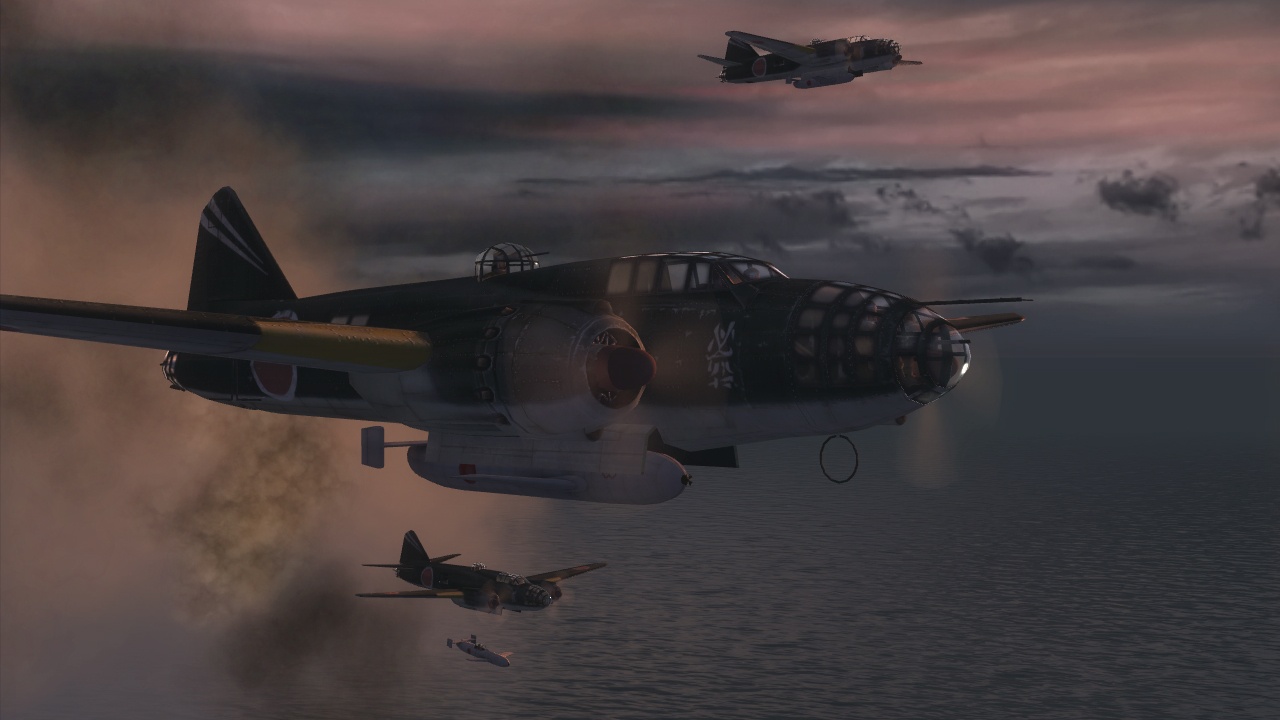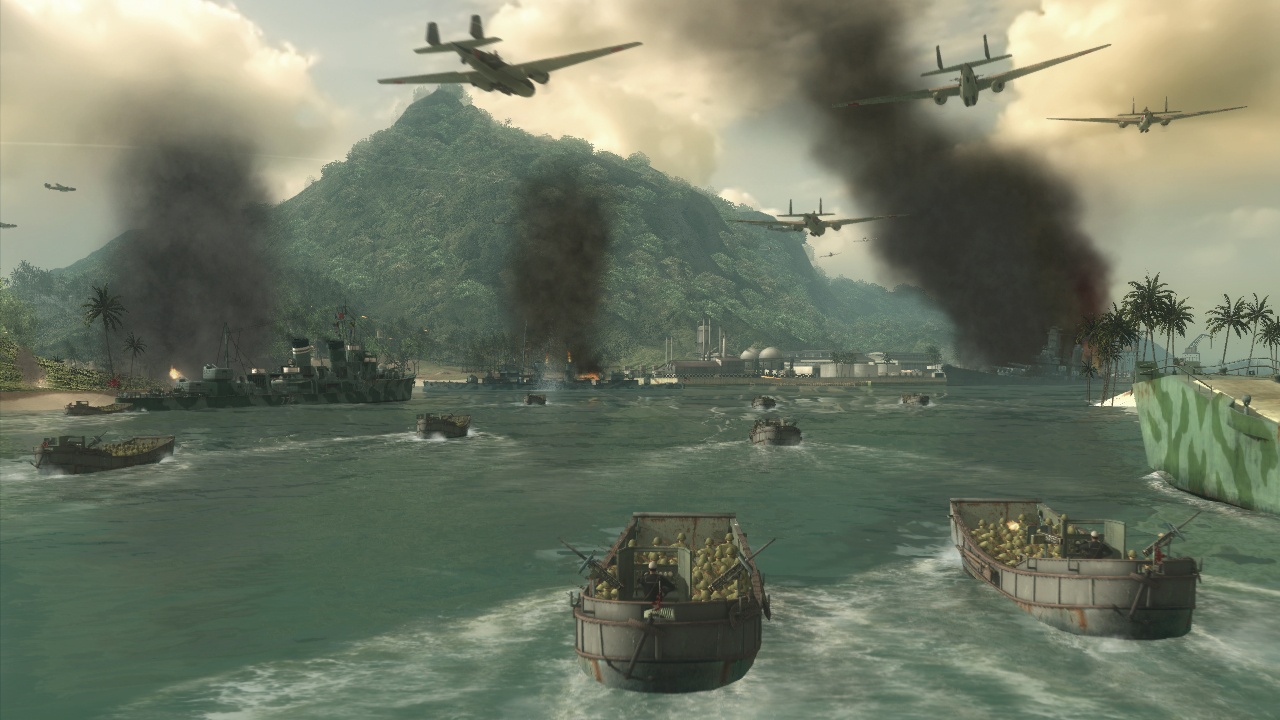Battlestations: Pacific Q&A: Kamikazes, troop landings, and the new Japanese campaign.
Midway was just the beginning. Fresh details from the Pacific and an exclusive new trailer.
Battlestations: Midway was not an ordinary World War II game. As you took command of the Pacific fleet in some of the largest naval battles ever fought, you had at your disposal battleships, submarines, aircraft carriers, dive-bombers, fighter planes, torpedo bombers, cruisers, and destroyers. More than just a real-time strategy game where you issued units simple orders to attack and defend, Battlestations: Midway put you in control of each of these units in a third-person action view. After orchestrating a battle plan on a top-down strategy map, you could then control any of your units, each with its own unique control schemes. The decisions were not always easy. Do you control the torpedo bomber and try to dodge AA flak to get a critical hit on an enemy carrier, or do you dive, dive, dive in a submarine and put a hole in an enemy battleship as it bears down on your own carrier? This blend of action and strategy set Battlestations: Midway apart.
That said, development for Battlestations: Midway was a long, arduous process as the game was pushed back several times and originally slated for release on the Xbox, not the Xbox 360. As such, the visuals were not exactly "next-gen," the single-player campaign was short, and multiplayer was limited to one mode. The concept was sound, but the execution was flawed. But that's why they make sequels.
Battlestations: Pacific, also by Eidos Hungary, is nearly double the size of Midway. Focusing on the rest of the Pacific campaign after Midway, including the invasion of Okinawa and Iwo Jima, Battlestations: Pacific will also feature a separate Japanese campaign in addition to expanded multiplayer. For the first time you'll also control parachute drops and troop landings as infantry will play a key role. We sat down with marketing manager David Bamberger and lead designer Botond Szalacsi for the first details on Battlestations: Pacific. Not enough? Check out our exclusive first video trailer.

GameSpot: Battlestations: Midway was an intriguing blend of real-time strategy and action gameplay, giving you the unique ability to organize aircraft carriers, fighter squadrons, submarines, battleships, and bombers while at the same time letting you control each individual unit yourself. What was your goal moving forward with Battlestations: Pacific?
David Bamberger: Battlestations: Pacific is massive. It's twice the size of the original, has two separate full-length single-player campaigns, 100 warships, and a five new multiplayer modes. We learned a great deal from the Battlestations community as well, and they've helped us improve interface and accessibility.
GS: Walk us through the major battles of Battlestations: Pacific. With 28 single-player missions, it sounds like there's a lot to do. Will we be raising the flag at Iwo Jima?
DB: In Battlestations: Midway, we showed players the US perspective on the war, but with Battlestations: Pacific we are revealing both the US and Japanese sides in two unique single-player campaigns. Players will command the US fleet after the battle of Midway to the end of the war. They will then command the Japanese fleet from the attack on Pearl Harbor to final victory. Relive or rewrite history is the idea. For me it shows how every battle, every D-day mattered. Flags will be raised on Tarawa, Guadalcanal, Iwo Jima, Okinawa, and more.
GS: Battlestations: Midway was hampered by mediocre visuals, an interface that wasn't exactly user-friendly, and one of the worst in-game tutorials in recent memory. What are you doing in Pacific to correct these issues?
DB: Visually it has helped to design specifically for the Xbox 360 and high-end PCs. This has allowed us to open up what we do graphically. Everything is better: environments, explosions, smoke and fire effects, lighting, destruction animations, underwater sea life, visible seabed. And now all planes have a cockpit view.
We have also improved accessibility--this has been a key objective for us. We have reworked the user interface, and players will now be able to carry out commands and control their units through more intuitive and effective mechanisms. Additionally, we have laid more emphasis on training players how to use their units, weapons, and tactics effectively against the enemy in specific contexts.
GS: The single-player campaign in Battlestations: Midway felt very narrow. As you played through the war as Henry Walker, you started out with nothing more than a PT boat, and only at the end of the campaign did you participate in the massive battles that made Battlestations stand out, like Midway and Guadalcanal. In Battlestations: Pacific, what methods are you using to drive the single-player story, and are you making an effort to introduce players to huge, multi-unit battles earlier?
DB: Yes, as early as possible. The story of the original limited us in ways. This time we're not using a character to narrate the story. So the answer was to not assign an imaginary role to the player but to allow the player to experience the battle playing many roles. These were the largest battles in human history. Battlestations: Pacific works to put you into the middle of the large air, sea, and sub battles at their highest points.
GS: Players will also be able to play through a Japanese single-player campaign, giving us a different view of the war, not unlike Clint Eastwood's two WWII films, Letters from Iwo Jima and Flags of our Fathers. Tell us about the decision to include a Japanese campaign and how you drive that side of the story?
DB: The original game offered special Japanese missions. It gave players insight into the Japanese Imperial Navy and what it was like to face the US fleet. Battlestations: Pacific offers an entire Japanese campaign. The trailer features a Kamikaze Special Forces pilot in his language and words. The words are from actual kamikaze pilot diaries and letters. Battlestations: Pacific offers a "what if" campaign that for me brings home that point that Japan was a smart and determined force. This is a perspective that also underscores the immensity of the US victory.
GS: Were there ever any red flags in deciding to play as the Japanese during the bombing of Pearl Harbor?
DB: You can apply that question to every battle of the war, from Pearl Harbor to Okinawa, which in many ways is why we focused on the battles as opposed to telling an imagined story with characters. The war and battles themselves tell the story and give you some insight into the real war.
I would recommend to anyone interested to read Sea of Thunder by Evan Thomas. It's about four commanders, two American and two Japanese, and describes how they grew to understand their enemy while they fought to destroy them.
GS: As Japanese pilots in multiplayer, we loved dodging American antiaircraft fire while attempting kamikaze strikes. The only problem was that these attacks barely scratched enemy ships. But now you've introduced the Ohka, a rocket-propelled craft designed specifically for kamikaze attacks--and also credited with significantly damaging seven US ships during the war. What effects will kamikaze attacks now have in Battlestations: Pacific, and what's the best way to use them strategically?
Botond Szalacsi The average kamikaze plane works exactly like other planes--but they are full of explosives, and they can cripple ships easily if they can reach them in time in the AA fire. The rocket-powered Ohka is a little bit different--carried to the battlefield under a slow-moving Japanese bomber, then released. It's a very dangerous opponent.
Japanese commanders can use them as the hardest-hitting planes in the game, planning sneak attacks against an enemy carrier or crippling any ship which they encounter.
Watch out for the combat air patrol, though. The tactics against them are quite simple--shoot them down before they reach you, or you are in serious trouble!
And of course Allies can do kamikaze attacks and ram enemy ships, but they won't do any serious damage to the Japanese vessels--the Allied air power lies in superior units, and they won't have a dedicated kamikaze unit in the game. The Corsair and Hellcat are the best kamikaze hunters.
GS: There were already a ton of military units in Battlestations: Midway, and now you tell us there are 20 new units to play as. What are they, what can they do, and what are some of your favorites?
BS: There are 100 units in the game--20 new ones, too many to list here, but we included most of the highly requested units from every type. My personal favorite is still the F4U Corsair equipped with rockets--a very effective plane which is great fun to play. From the Japanese side, I would choose the I-400, which was the biggest submarine of the whole second world war--a very dangerous underwater unit in the hands of a skilled commander.
GS: Battlestations: Midway attracted a niche following when the multiplayer demo was released on Xbox Live. The players who got past the wonky interface and lack of tutorial discovered a surprisingly addictive blend of action and strategy. How have you expanded multiplayer in Battlestations: Pacific, from number of maps to number of players to PC-Xbox 360 cross-platform play?
DB: We will be talking about multiplayer modes in the near future. But yes, it was important to expand this, and we have. We will not be supporting cross-platform play.
GS: Hey, you know we don't speak Japanese. What exactly is being said in the new Battlestations: Pacific trailer?
DB: Go to Battlestations.net for the translation.

GS: An exciting new feature is tactical troop landings, in which airborne troops parachute into enemy territory. Walk us through the troop landing. Can players actually control individual soldiers or even the parachute drop? What about storming the beaches from iconic Higgins boats?
BS: Island capture is a new feature where players can capture islands and take control of weapons, radar, and more. We felt that just controlling individual soldiers would take the focus away from the fighting machines. Battlestations: Pacific works on a different scale, so we decided that the player should be able to control a variety of landing ships, LSTs, and huge transport ships--these carry dozens of small assault boats that you can launch to the shores. They are similar to other in-game units, you can fully command and control them, and launch the assault when you are close to the landing zone. Also, I have to mention the transport planes filled with paratroopers--you can also control these planes and decide where you want to deploy your troops.
GS: Thanks for your time.
Got a news tip or want to contact us directly? Email news@gamespot.com
Join the conversation